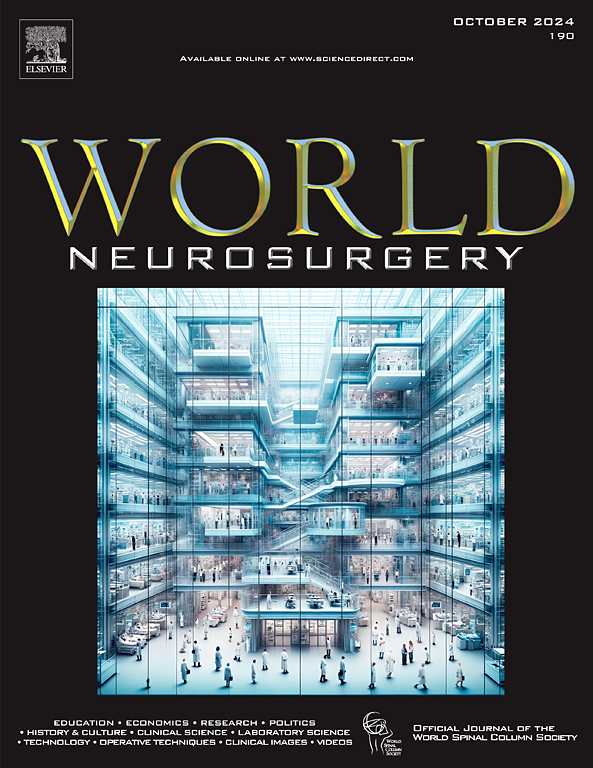DTI Analysis of the Peritumoral Zone of Diffuse Low-grade Gliomas in Progressing Patients
IF 2.1
4区 医学
Q3 CLINICAL NEUROLOGY
引用次数: 0
Abstract
Background
Diffuse low-grade gliomas are rare brain tumors transforming to higher grade even with surgery, chemotherapy, and radiotherapy. Their preferential infiltration of white matter tracts, beyond tumor boundaries on fluid-attenuated inversion recovery (FLAIR), make difficult to plan focal treatment such as surgery or radiotherapy and monitor response to chemotherapy. Diffusion tensor imaging (DTI) might reflect this infiltration of white matter tracts. The aim of our study is to assess how DTI signal in the peritumoral zone might be modified before FLAIR tumor progression appears at 1-year follow-up.
Methods
The study retrospectively enrolled 5 patients who met inclusion criteria: DTI with 25 directions, T1 and FLAIR at initial imaging; FLAIR at one-year follow-up. Patients with surgery, radiotherapy, and chemotherapy completed less than 2 years before initial imaging were excluded. FLAIR tumor progression, named progression mask, was assessed by subtracting tumor masks between initial imaging and one-year follow-up. Initial DTI signal was analyzed within this progression mask and compared with the healthy contralateral side.
Results
Tumor progression was confirmed for the 5 patients at 1 year. All patients showed pre-existing DTI signal abnormalities within the progression mask. Mean fractional anisotropy (P = 0.03) was lower in the progression mask, whereas mean diffusivity, axial diffusivity, and radial diffusivity mean (P = 0.03) was higher in the progression mask, compared with the healthy side.
Conclusions
This study shows pre-existing DTI signal abnormalities in regions with tumor progression at 1 year. Such abnormalities could correspond to a tumor infiltration not yet visible on FLAIR. This might be helpful to predict tumor progression and allow to adapt the therapeutic strategy.
对进展期弥漫性低级别胶质瘤患者瘤周区的 DTI 分析。
背景:DLGGs是一种罕见的脑肿瘤,即使经过手术、化疗和放疗,也会向更高级别转化。在 FLAIR 图像上,DLGG 偏好浸润肿瘤边界以外的 WM 束,这给手术、放疗等病灶治疗计划的制定以及化疗反应的监测带来了困难。DTI 可反映这种 WM 束浸润。我们的研究旨在评估在一年随访中出现 FLAIR 肿瘤进展之前,瘤周区的 DTI 信号会发生怎样的改变:本研究回顾性地纳入了符合纳入标准的五名患者:方法:该研究回顾性纳入了5名符合纳入标准的患者,他们在初次成像时接受了25个方向的DTI、T1和FLAIR成像;在一年的随访中接受了FLAIR成像。首次成像前完成手术、放疗和化疗不足 2 年的患者排除在外。通过减去初次成像和一年随访期间的肿瘤掩膜,评估 FLAIR 肿瘤进展情况(称为进展掩膜)。在此进展掩膜内分析初始 DTI 信号,并与健康的对侧进行比较:结果:五名患者在一年后均证实肿瘤进展。所有患者在进展掩膜内均显示出原有的 DTI 信号异常。与健康侧相比,进展遮盖区的平均 FA 值(p = 0.03)较低,而 MD、AD 和 RD 平均值(p = 0.03)较高:结论:本研究显示,肿瘤进展区域在一年前就存在 DTI 信号异常。这些异常可能与 FLAIR 尚未显示的肿瘤浸润相对应。这可能有助于预测肿瘤进展并调整治疗策略。
本文章由计算机程序翻译,如有差异,请以英文原文为准。
求助全文
约1分钟内获得全文
求助全文
来源期刊

World neurosurgery
CLINICAL NEUROLOGY-SURGERY
CiteScore
3.90
自引率
15.00%
发文量
1765
审稿时长
47 days
期刊介绍:
World Neurosurgery has an open access mirror journal World Neurosurgery: X, sharing the same aims and scope, editorial team, submission system and rigorous peer review.
The journal''s mission is to:
-To provide a first-class international forum and a 2-way conduit for dialogue that is relevant to neurosurgeons and providers who care for neurosurgery patients. The categories of the exchanged information include clinical and basic science, as well as global information that provide social, political, educational, economic, cultural or societal insights and knowledge that are of significance and relevance to worldwide neurosurgery patient care.
-To act as a primary intellectual catalyst for the stimulation of creativity, the creation of new knowledge, and the enhancement of quality neurosurgical care worldwide.
-To provide a forum for communication that enriches the lives of all neurosurgeons and their colleagues; and, in so doing, enriches the lives of their patients.
Topics to be addressed in World Neurosurgery include: EDUCATION, ECONOMICS, RESEARCH, POLITICS, HISTORY, CULTURE, CLINICAL SCIENCE, LABORATORY SCIENCE, TECHNOLOGY, OPERATIVE TECHNIQUES, CLINICAL IMAGES, VIDEOS
 求助内容:
求助内容: 应助结果提醒方式:
应助结果提醒方式:


